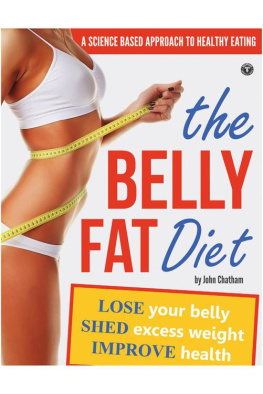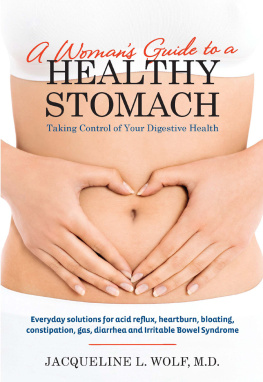
Notice
This book is intended as a reference volume only, not as a medical manual. The information given here is designed to help you make informed decisions about your health. It is not intended as a substitute for any treatment that may have been prescribed by your doctor. If you suspect that you have a medical problem, we urge you to seek competent medical help. Mention of specific companies, organizations, or authorities in this book does not imply endorsement by the author or publisher, nor does mention of specific companies, organizations, or authorities imply that they endorse this book, its author, or the publisher. Internet addresses and telephone numbers given in this book were accurate at the time it went to press.
This edition first published in the UK in 2006 by
Rodale International Ltd
710 Chandos Street
London W1G 9AD
www.rodalebooks.co.uk
This book was originally published in French as Et si a venait du ventre? by Editions Robert Laffont, SA, Paris, 2002.
English translation by Translate-a-Book, Oxford, England
2006 by ditions Robert Laffont, S.A., Paris, 2002, 2006
On behalf of Pierre Pallardy, Robert Laffont has asserted Pierre Pallardys right to be identified as author of this work, in accordance with the Copyright, Designs and Patents Act of 1988.
All rights reserved. No part of this publication may be reproduced or transmitted in any form or by any means, electronic or mechanical, including photocopying, recording, or any other information storage and retrieval system, without the written permission of the publisher.
Book design by Paul Ashby
Library of Congress Cataloging-in-Publication Data
Pallardy, Pierre.
Gut Instinct / What your stomach is trying to tell you / Pierre Pallardy.
p. cm.
Includes index.
eISBN-13 9781594865428 ebook
ISBN-13 9781594865428 paperback
ISBN-10 1594865426 paperback
1. StomachDiseasesTreatmentPopular works. I. Title.
RC817.P354 2006
616.3'3dc22 2006033657

We inspire and enable people to improve their lives and the world around them
For more of our products visit rodalestore.com or call 800-848-4735
This book is dedicated to therapists, osteopaths, nurses, midwives, and medical practitioners everywherein short, to all those who use a hands-on approach to alleviate their patients suffering and guide them back along the often difficult path to health and well-being.
CONTENTS

INTRODUCTION
O VER MANY YEARS , MY VOCATION as a therapist has brought me into contact with countless patients plagued by all manner of physical and psychological complaints, which have caused them great suffering. In some cases, they felt their lives were almost not worth living. Each one has sought a solution to their problems, determined to find a means of achieving that special feeling of harmony and happiness that comes from the health and well-being that should be our birthright.
In almost every single instance, there was little need to delve into their medical history: I could read it in their eyes. These were patients in distress, patients who had consulted one specialist after another, patients who had followed strict diets and experimented with every treatment under the sun, eagerly espousing each and every miracle cure that came on the market and dutifully swallowing everything from anti-depressants to mega-vitamins. Typically, they tried whatever was offered in a despairing bid to find some means of putting an end to their discomfort and suffering.
The stresses and strains of modern life are all around us. We are plagued by the speed of events, which offer little scope for relaxation. We eat too quickly, whenever or wherever we can, consuming food without regard to its nutritional value. We eat too much sugar. We eat too many fatty foods. At times, in an attempt to remedy an unhealthy lifestyle, we indulge in sporadic exercise, turning to sports that are often too extreme or, at best, poorly adapted to our physical needs. Nothing seems to work. We remain exhausted. We sleep badly. We are out of condition, overweight, tortured by back pain. We accumulate allergies, we suffer from rheumatism and arthritis, we develop sexual problems, such as impotence or loss of libido. All too often, I can see the first signs of premature aging on a patients face. And, in the vast majority of instances, I detect the spiral of stress that leads inexorably down towards depression.
This makes me angry. As a practicing osteopath, dietitian, and physiotherapist with 35 years of clinical experience, I know that almost all these physical and mental ailments could have been avoided in the first instance and, once established, can still be successfully treated and cured. The sole pre-conditions are willingness to eliminate certain bad habits, to eat sensibly, and to change the way you breathe; my simple set of behavioural rules will also change the way in which you perceive yourself. It is simply a question of understanding that complaints such as those outlined above are almost exclusively abdomen-related. They have their origins in the abdomen and it is there that a cure must be sought.
To put it bluntly, we must learn to trust our gut instincts.
The Abdomen as Epicenter
On the face of it, asserting that everything relates back to the abdomen may not appear particularly logical or even defensible. Since my early days as a practicing therapist, however, I have believed that treating the abdomen is an essential part of the therapeutic process. I would even go so far as to say that the abdomen is the epicenter of life. Throughout my career, my first reflex has always been to seek a remedy by adopting a hands-on approach to the abdomen, regardless of the patients initial complaint.
In my very first book, La grande forme (Top Form, published in 1979), I stressed the importance of maintaining the abdomen in the best possible condition and getting plenty of oxygen to the area. In 1981, in En pleine sant (Total Health), I traced the close links between recurrent complaints and abdominal dysfunction. Then, in Manger pour gurir (Eating for Health, published in 1985), I set out a basic method for achieving a sense of well-being. I quote Manger pour gurir:
For over twenty years, patients have been coming to me on a daily basis complaining of back and neck pain, of aching joints, of sleeping disorders, of a general feeling of lassitude and exhaustion. Some have described excruciatingly painful migraines, others have protested that their nerves were frayed to the point where they were unable to carry on. Without fail, when I examined their back, neck, and limbs, I immediately detected signs of knots and tension. But when I palpated their abdomen, I also discovered that the area was hard, bloated, under stress. Typically, severe pain manifested itself at certain points on the plexusthat complex network of minute and closely interwoven and interconnecting fibers and tubesand along certain meridians, the pathways in the body along which energy flows. I would treat the patient by gently massaging the abdomen, progressively releasing the knots of tension. As I proceeded, I could feel the patient gradually relax as his or her condition improved.











